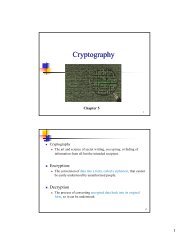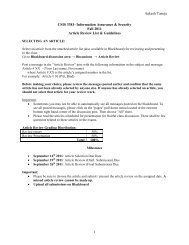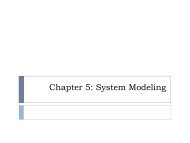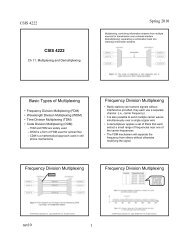Slides for Rosen, 5th edition - Index of
Slides for Rosen, 5th edition - Index of
Slides for Rosen, 5th edition - Index of
Create successful ePaper yourself
Turn your PDF publications into a flip-book with our unique Google optimized e-Paper software.
Analysis <strong>of</strong> Algorithms &<br />
Orders <strong>of</strong> Growth<br />
<strong>Rosen</strong> 6 th ed., §3.1-3.3<br />
1
Analysis <strong>of</strong> Algorithms<br />
• An algorithm is a finite set <strong>of</strong> precise instructions<br />
<strong>for</strong> per<strong>for</strong>ming a computation or <strong>for</strong> solving a<br />
problem.<br />
• What is the goal <strong>of</strong> analysis <strong>of</strong> algorithms?<br />
– To compare algorithms mainly in terms <strong>of</strong> running time<br />
but also in terms <strong>of</strong> other factors (e.g., memory<br />
requirements, programmer's ef<strong>for</strong>t etc.)<br />
• What do we mean by running time analysis?<br />
– Determine how running time increases as the size <strong>of</strong><br />
the problem increases.<br />
2
Example: Searching<br />
• Problem <strong>of</strong> searching an ordered list.<br />
– Given a list L <strong>of</strong> n elements that are sorted into<br />
a definite order (e.g., numeric, alphabetical),<br />
– And given a particular element x,<br />
– Determine whether x appears in the list, and if<br />
so, return its index (position) in the list.<br />
3
Search alg. #1: Linear Search<br />
procedure linear search<br />
(x: integer, a 1 , a 2 , …, a n : distinct integers)<br />
i := 1<br />
while (i ≤ n ∧ x ≠ a i )<br />
i := i + 1<br />
if i ≤ n then location := i<br />
else location := 0<br />
return location {index or 0 if not found}<br />
4
Search alg. #2: Binary Search<br />
• Basic idea: On each step, look at the middle<br />
element <strong>of</strong> the remaining list to eliminate<br />
half <strong>of</strong> it, and quickly zero in on the desired<br />
element.<br />
Search alg. #2: Binary Search<br />
procedure binary search<br />
(x:integer, a 1 , a 2 , …, a n : distinct integers)<br />
i := 1 {left endpoint <strong>of</strong> search interval}<br />
j := n {right endpoint <strong>of</strong> search interval}<br />
while i1 item}<br />
m := ⎣(i+j)/2⎦ {midpoint}<br />
if x>a m then i := m+1 else j := m<br />
end<br />
if x = a i then location := i else location := 0<br />
return location<br />
6
Is Binary Search more efficient?<br />
• Number <strong>of</strong> iterations:<br />
– For a list <strong>of</strong> n elements, Binary Search can<br />
execute at most log 2 n times!!<br />
– Linear Search, on the other hand, can execute up<br />
to n times !!<br />
Average Number <strong>of</strong> Iterations<br />
Length Linear Search Binary Search<br />
10 5.5 2.9<br />
100 50.5 5.8<br />
1,000 500.5 9.0<br />
10,000 5000.5 12.0<br />
7
Is Binary Search more efficient?<br />
• Number <strong>of</strong> computations per iteration:<br />
– Binary search does more computations than<br />
Linear Search per iteration.<br />
• Overall:<br />
– If the number <strong>of</strong> components is small (say, less<br />
than 20), then Linear Search is faster.<br />
– If the number <strong>of</strong> components is large, then<br />
Binary Search is faster.<br />
8
How do we analyze algorithms?<br />
• We need to define a number <strong>of</strong> objective measures.<br />
(1) Compare execution times?<br />
Not good: times are specific to a particular computer !!<br />
(2) Count the number <strong>of</strong> statements executed?<br />
Not good: number <strong>of</strong> statements vary with the<br />
programming language as well as the style <strong>of</strong> the<br />
individual programmer.<br />
9
Example (# <strong>of</strong> statements)<br />
Algorithm 1 Algorithm 2<br />
arr[0] = 0; <strong>for</strong>(i=0; i
How do we analyze algorithms?<br />
(3) Express running time as a function <strong>of</strong><br />
the input size n (i.e., f(n)).<br />
– To compare two algorithms with running times<br />
f(n) and g(n), we need a rough measure <strong>of</strong><br />
how fast a function grows.<br />
– Such an analysis is independent <strong>of</strong> machine<br />
time, programming style, etc.<br />
11
Computing running time<br />
• Associate a "cost" with each statement and find the<br />
"total cost“ by finding the total number <strong>of</strong> times<br />
each statement is executed.<br />
• Express running time in terms <strong>of</strong> the size <strong>of</strong> the<br />
problem.<br />
Algorithm 1 Algorithm 2<br />
Cost Cost<br />
arr[0] = 0; c1 <strong>for</strong>(i=0; i
Computing running time (cont.)<br />
Cost<br />
sum = 0; c1<br />
<strong>for</strong>(i=0; i
Comparing Functions Using<br />
Rate <strong>of</strong> Growth<br />
• Consider the example <strong>of</strong> buying elephants and<br />
goldfish:<br />
Cost: cost_<strong>of</strong>_elephants + cost_<strong>of</strong>_goldfish<br />
Cost ~ cost_<strong>of</strong>_elephants (approximation)<br />
• The low order terms in a function are relatively<br />
insignificant <strong>for</strong> large n<br />
n 4 + 100n 2 + 10n + 50 ~ n 4<br />
i.e., n 4 + 100n 2 + 10n + 50 and n 4 have the same<br />
rate <strong>of</strong> growth<br />
14
Rate <strong>of</strong> Growth ≡Asymptotic Analysis<br />
• Using rate <strong>of</strong> growth as a measure to compare<br />
different functions implies comparing them<br />
asymptotically.<br />
• If f(x) is faster growing than g(x), then f(x)<br />
always eventually becomes larger than g(x) in<br />
the limit (<strong>for</strong> large enough values <strong>of</strong> x).<br />
15
Example<br />
• Suppose you are designing a web site to process<br />
user data (e.g., financial records).<br />
• Suppose program A takes f A (n)=30n+8<br />
microseconds to process any n records, while<br />
program B takes f B (n)=n 2 +1 microseconds to<br />
process the n records.<br />
• Which program would you choose, knowing<br />
you’ll want to support millions <strong>of</strong> users?<br />
16
Visualizing Orders <strong>of</strong> Growth<br />
• On a graph, as<br />
you go to the<br />
right, a faster<br />
growing<br />
function<br />
eventually<br />
becomes<br />
larger...<br />
Value <strong>of</strong> function →<br />
f B (n)=n 2 +1<br />
Increasing n →<br />
f A (n)=30n+8<br />
17
Big-O Notation<br />
• We say f A (n)=30n+8is order n, or O(n).<br />
It is, at most, roughly proportional to n.<br />
• f B (n)=n 2 +1 is order n 2 , or O(n 2 ). It is, at<br />
most, roughly proportional to n 2 .<br />
• In general, an O(n 2 ) algorithm will be<br />
slower than O(n) algorithm.<br />
• Warning: an O(n 2 ) function will grow<br />
faster than an O(n) function.<br />
18
More Examples …<br />
• We say that n 4 + 100n 2 + 10n + 50 is <strong>of</strong> the<br />
order <strong>of</strong> n 4 or O(n 4 )<br />
• We say that 10n 3 + 2n 2 is O(n 3 )<br />
• We say that n 3 - n 2 is O(n 3 )<br />
• We say that 10 is O(1),<br />
• We say that 1273 is O(1)<br />
19
Big-O Visualization<br />
20
Computing running time<br />
Algorithm 1 Algorithm 2<br />
Cost Cost<br />
arr[0] = 0; c1 <strong>for</strong>(i=0; i
Computing running time (cont.)<br />
Cost<br />
sum = 0; c1<br />
<strong>for</strong>(i=0; i
Running time <strong>of</strong> various statements<br />
while-loop<br />
<strong>for</strong>-loop<br />
23
Examples<br />
i = 0;<br />
while (i
Examples (cont.’d)<br />
if (i
Asymptotic Notation<br />
• O notation: asymptotic “less than”:<br />
– f(n)=O(g(n)) implies: f(n) “≤” g(n)<br />
• Ω notation: asymptotic “greater than”:<br />
– f(n)= Ω (g(n)) implies: f(n) “≥” g(n)<br />
• Θ notation: asymptotic “equality”:<br />
– f(n)= Θ (g(n)) implies: f(n) “=” g(n)<br />
26
Definition: O(g), at most order g<br />
Let f,g are functions R→R.<br />
• We say that “f is at most order g”, if:<br />
∃c,k: f(x) ≤ cg(x), ∀x>k<br />
– “Beyond some point k, function f is at most a<br />
constant c times g (i.e., proportional to g).”<br />
• “f is at most order g”, or “f is O(g)”, or<br />
“f=O(g)” all just mean that f∈O(g).<br />
• Sometimes the phrase “at most” is omitted.<br />
27
Big-O Visualization<br />
k<br />
28
Points about the definition<br />
• Note that f is O(g) as long as any values <strong>of</strong> c<br />
and k exist that satisfy the definition.<br />
• But: The particular c, k, values that make<br />
the statement true are not unique: Any<br />
larger value <strong>of</strong> c and/or k will also work.<br />
• You are not required to find the smallest c<br />
and k values that work. (Indeed, in some<br />
cases, there may be no smallest values!)<br />
However, you should prove that the values you choose do work.<br />
29
“Big-O” Pro<strong>of</strong> Examples<br />
• Show that 30n+8 is O(n).<br />
– Show ∃c,k: 30n+8 ≤ cn, ∀n>k .<br />
• Let c=31, k=8. Assume n>k=8. Then<br />
cn = 31n = 30n + n > 30n+8, so 30n+8 < cn.<br />
• Show that n 2 +1 is O(n 2 ).<br />
– Show ∃c,k: n 2 +1 ≤ cn 2 , ∀n>k:.<br />
• Let c=2, k=1. Assume n>1. Then<br />
cn 2 = 2n 2 = n 2 +n 2 > n 2 +1, or n 2 +1< cn 2 .<br />
30
Big-O example, graphically<br />
• Note 30n+8 isn’t<br />
less than n<br />
anywhere (n>0).<br />
• It isn’t even<br />
less than 31n<br />
everywhere.<br />
• But it is less than<br />
31n everywhere to<br />
the right <strong>of</strong> n=8.<br />
Value <strong>of</strong> function →<br />
cn =<br />
31n<br />
n>k=8 →<br />
30n+8<br />
n<br />
Increasing n →<br />
30n+8<br />
∈O(n)<br />
31
Common orders <strong>of</strong> magnitude<br />
32
Order-<strong>of</strong>-Growth in Expressions<br />
• “O(f)” can be used as a term in an arithmetic<br />
expression .<br />
E.g.: we can write “x 2 +x+1” as “x 2 +O(x)” meaning<br />
“x 2 plus some function that is O(x)”.<br />
• Formally, you can think <strong>of</strong> any such expression as<br />
denoting a set <strong>of</strong> functions:<br />
“x 2 +O(x)” :≡ {g | ∃f∈O(x): g(x)= x 2 +f(x)}<br />
34
Useful Facts about Big O<br />
• Constants ...<br />
∀c>0, O(cf)=O(f+c)=O(f−c)=O(f)<br />
• Sums:<br />
- If g∈O(f) and h∈O(f), then g+h∈O(f).<br />
- If g∈O(f 1 ) and h∈O(f 2 ), then<br />
g+h∈O(f 1 +f 2 ) =O(max(f 1 ,f 2 ))<br />
(Very useful!)<br />
35
More Big-O facts<br />
• Products:<br />
If g∈O(f 1 ) and h∈O(f 2 ), then gh∈O(f 1 f 2 )<br />
• Big O, as a relation, is transitive:<br />
f∈O(g) ∧ g∈O(h) → f∈O(h)<br />
36
More Big O facts<br />
• ∀ f,g & constants a,b∈R, with b≥0,<br />
– af = O(f) (e.g. 3x 2 = O(x 2 ))<br />
– f+O(f) = O(f) (e.g. x 2 +x = O(x 2 ))<br />
– |f| 1-b = O(f) (e.g. x −1 = O(x))<br />
– (log b |f|) a = O(f) (e.g. log x = O(x))<br />
– g=O(fg) (e.g. x = O(x log x))<br />
– fg ≠ O(g) (e.g. x log x ≠ O(x))<br />
– a=O(f) (e.g. 3 = O(x))<br />
37
Definition: Ω(g), at least order g<br />
Let f,g be any function R→R.<br />
• We say that “f is at least order g”, written Ω(g), if<br />
∃c,k: f(x) ≥ cg(x), ∀x>k<br />
– “Beyond some point k, function f is at least a constant c<br />
times g (i.e., proportional to g).”<br />
– Often, one deals only with positive functions and can<br />
ignore absolute value symbols.<br />
• “f is at least order g”, or “f is Ω(g)”, or “f= Ω(g)”<br />
all just mean that f∈ Ω(g).<br />
38
Big- Ω Visualization<br />
39
Definition: Θ(g), exactly order g<br />
• If f∈O(g) and g∈O(f) then we say “g and f<br />
are <strong>of</strong> the same order” or “f is (exactly) order<br />
g” and write f∈Θ(g).<br />
• Another equivalent definition:<br />
∃c 1 c 2 ,k: c 1 g(x)≤f(x)≤c 2 g(x), ∀x>k<br />
• “Everywhere beyond some point k, f(x) lies in<br />
between two multiples <strong>of</strong> g(x).”<br />
• Θ(g) ≡ O(g) ∩ Ω(g)<br />
(i.e., f∈O(g) and f∈Ω(g) )<br />
40
Big- Θ Visualization<br />
41
Rules <strong>for</strong> Θ<br />
• Mostly like rules <strong>for</strong> O( ), except:<br />
• ∀ f,g>0 & constants a,b∈R, with b>0,<br />
af ∈Θ(f) ← Same as with O.<br />
f ∉Θ(fg) unless g=Θ(1) ← Unlike O.<br />
|f| 1-b ∉Θ(f), and ← Unlike with O.<br />
(log b |f|) c ∉Θ(f). ← Unlike with O.<br />
• The functions in the latter two cases we say<br />
are strictly <strong>of</strong> lower order than Θ(f).<br />
42
Θ example<br />
• Determine whether:<br />
n<br />
⎞<br />
?<br />
⎜<br />
⎛ ∑i⎟∈Θ( n<br />
2 )<br />
⎝ i=<br />
1 ⎠<br />
n<br />
⎛ ⎞<br />
⎜∑i⎟<br />
= n( n + 1)/2<br />
⎝ i=<br />
1 ⎠<br />
= n⋅Θ( n)/2<br />
= n⋅Θ( n)<br />
• Quick solution:<br />
=Θ<br />
2<br />
( n )<br />
43
Other Order-<strong>of</strong>-Growth Relations<br />
• o(g) = {f | ∀c ∃k: f(x) < cg(x), ∀x>k}<br />
“The functions that are strictly lower order<br />
than g.” o(g) ⊂ O(g) − Θ(g).<br />
• ω(g) = {f | ∀c ∃k: cg(x) < f(x), ∀x>k }<br />
“The functions that are strictly higher order<br />
than g.” ω(g) ⊂ Ω(g) − Θ(g).<br />
44
Relations Between the Relations<br />
• Subset relations between order-<strong>of</strong>-growth<br />
sets.<br />
R→R<br />
Ω( f )<br />
O( f )<br />
Θ( f ) ω( f )<br />
o( f )<br />
• f<br />
45
Strict Ordering <strong>of</strong> Functions<br />
• Temporarily let’s write fpg to mean f∈o(g),<br />
f~g to mean f∈Θ(g)<br />
• Note that<br />
f ( x)<br />
f p g ⇔ lim = 0.<br />
x→∞<br />
g(<br />
x)<br />
• Let k>1. Then the following are true:<br />
1 p log log n p log n ~ log k n p log k n<br />
p n 1/k p n p n log n p n k p k n p n! p n n …<br />
46
Common orders <strong>of</strong> magnitude<br />
47
Review: Orders <strong>of</strong> Growth<br />
Definitions <strong>of</strong> order-<strong>of</strong>-growth sets,<br />
∀g:R→R<br />
• O(g) ≡ {f | ∃ c,k: f(x) ≤ cg(x), ∀x>k }<br />
• o(g) ≡ {f | ∀c ∃k: f(x) < cg(x),∀x>k }<br />
• Ω(g) ≡ {f| | ∃c,k : f(x) ≥ cg(x),∀x>k }<br />
• ω(g) ≡ {f | ∀ c ∃k: f(x) >cg(x), ∀x>k}<br />
• Θ(g) ≡ {f | ∃c 1 c 2 ,k: c 1 g(x)≤f(x)|≤c 2 g(x), ∀x>k}<br />
48
Algorithmic and Problem<br />
Complexity<br />
<strong>Rosen</strong> 6 th ed., §3.3<br />
49
Algorithmic Complexity<br />
• The algorithmic complexity <strong>of</strong> a<br />
computation is some measure <strong>of</strong> how<br />
difficult it is to per<strong>for</strong>m the computation.<br />
• Measures some aspect <strong>of</strong> cost <strong>of</strong><br />
computation (in a general sense <strong>of</strong> cost).<br />
50
Problem Complexity<br />
• The complexity <strong>of</strong> a computational problem<br />
or task is the complexity <strong>of</strong> the algorithm<br />
with the lowest order <strong>of</strong> growth <strong>of</strong><br />
complexity <strong>for</strong> solving that problem or<br />
per<strong>for</strong>ming that task.<br />
• E.g. the problem <strong>of</strong> searching an ordered list<br />
has at most logarithmic time complexity.<br />
(Complexity is O(log n).)<br />
51
Tractable vs. Intractable Problems<br />
• A problem or algorithm with at most<br />
polynomial time complexity is considered<br />
tractable (or feasible). P is the set <strong>of</strong> all<br />
tractable problems.<br />
• A problem or algorithm that has more than<br />
polynomial complexity is considered<br />
intractable (or infeasible).<br />
52
Dealing with Intractable Problems<br />
• Many times, a problem is intractable <strong>for</strong> a small<br />
number <strong>of</strong> input cases that do not arise in practice<br />
very <strong>of</strong>ten.<br />
– Average running time is a better measure <strong>of</strong> problem<br />
complexity in this case.<br />
– Find approximate solutions instead <strong>of</strong> exact solutions.<br />
53
Unsolvable problems<br />
• It can be shown that there exist problems that no<br />
algorithm exists <strong>for</strong> solving them.<br />
• Turing discovered in the 1930’s that there are<br />
problems unsolvable by any algorithm.<br />
• Example: the halting problem (see page 176)<br />
– Given an arbitrary algorithm and its input, will that<br />
algorithm eventually halt, or will it continue <strong>for</strong>ever in<br />
an “infinite loop?”<br />
54
NP and NP-complete<br />
• NP is the set <strong>of</strong> problems <strong>for</strong> which there exists a<br />
tractable algorithm <strong>for</strong> checking solutions to see if<br />
they are correct.<br />
• NP-complete is a class <strong>of</strong> problems with the<br />
property that if any one <strong>of</strong> them can be solved by a<br />
polynomial worst-case algorithm, then all <strong>of</strong> them<br />
can be solved by polynomial worst-case<br />
algorithms.<br />
– Satisfiability problem: find an assignment <strong>of</strong> truth<br />
values that makes a compound proposition true.<br />
55
P vs. NP<br />
• We know P⊆NP, but the most famous<br />
unproven conjecture in computer science is<br />
that this inclusion is proper (i.e., that P⊂NP<br />
rather than P=NP).<br />
• It is generally accepted that no NPcomplete<br />
problem can be solved in<br />
polynomial time.<br />
• Whoever first proves it will be famous!<br />
56
Questions<br />
• Find the best big-O notation to describe the<br />
complexity <strong>of</strong> following algorithms:<br />
– A linear search to find the largest number in a<br />
list <strong>of</strong> n numbers (Algorithm 1)<br />
– A linear search to arbitrary number (Algorithm<br />
2)<br />
57
Questions (cont’d)<br />
– The number <strong>of</strong> print statements in the following<br />
<strong>for</strong> (i=1, i≤n; i++)<br />
<strong>for</strong> (j=1, j ≤n; j++)<br />
print “hello”<br />
58










